Reducing Cd and Pb Accumulation in Potatoes: The Role of Soil Passivators in Contaminated Mining Soils
Abstract
1. Introduction
2. Materials and Methods
2.1. Overview of the Study Area
2.2. Test Materials
2.3. Experimental Design
2.4. Sample Collection, Measurement, and Analysis
2.4.1. Sample Collection
2.4.2. Determination of Soil Physical and Chemical Properties
2.4.3. Determination of Potato Quality
2.5. Data Analysis
3. Results
3.1. Physicochemical Properties of Soil
3.2. Bioavailable Cadmium (Cd) and Lead (Pb) Content in Potato Rhizosphere Soil
3.3. Effects of Different Treatments on Cd and Pb Content in Various Parts of Potato
3.4. Effects of Different Treatments on Cd and Pb Accumulation Coefficients in Various Parts of Potato
3.5. Effects of Different Treatments on Transport Coefficients of Cd and Pb in Various Parts of Potato
3.6. Correlation Analysis
3.7. Effects of Different Treatments on Potato Yield and Quality
4. Discussion
5. Conclusions
Author Contributions
Funding
Institutional Review Board Statement
Informed Consent Statement
Data Availability Statement
Conflicts of Interest
References
- Han, F.; An, S.Y.; Liu, L.; Ma, L.Q.; Wang, Y.; Yang, L. Simultaneous enhancement of soil properties along with water-holding and restriction of Pb–Cd mobility in a soil-plant system by the addition of a phosphorus-modified biochar to the soil. J. Environ. Manag. 2023, 345, 118827. [Google Scholar] [CrossRef]
- Tóth, G.; Hermann, T.; Szatmári, G.; Pásztor, L. Maps of heavy metals in the soils of the European Union and proposed priority areas for detailed assessment. Sci. Total Environ. 2016, 565, 1054–1062. [Google Scholar] [CrossRef] [PubMed]
- Adewumi, A.J.; Laniyan, T.A. Contamination, ecological, and human health risks of heavy metals in water from a Pb–Zn–F mining area, North Eastern Nigeria. J. Water Health 2013, 21, 1470–1488. [Google Scholar] [CrossRef]
- Smolders, A.J.P.; Guerrero Hiza, M.A.; Van der Velde, G.; Roelofs, J.G.M. Dynamics of discharge, sediment transport, heavy metal pollution and Sábalo (Prochilodus lineatus) catches in the lower Pilcomayo river (Bolivia). River Res. Appl. 2002, 18, 415–427. [Google Scholar] [CrossRef]
- Steele, S.G.; Toribio, J.A.L.; Mor, S.M. A vision of a One Health system for Australia: On the need to rethink our health system. Med. J. Aust. 2022, 217, 459. [Google Scholar] [CrossRef]
- Guozheng, L. Upgrading and Reshaping of Mine Geological Restoration Model in New Era: Conceptual Analysis Based on “Geological Restoration 3.0”. Northwestern Geol. 2019, 52, 270–278. [Google Scholar]
- Gao, Y.; Wu, P.; Jeyakumar, P.; Bolan, N.; Wang, H.; Gao, B.; Wang, S.; Wang, B. Biochar as a potential strategy for remediation of contaminated mining soils: Mechanisms, applications, and future perspectives. J. Environ. Manag. 2022, 313, 114973. [Google Scholar] [CrossRef]
- Wang, X.; Sun, C.P.; Yang, P.; Zhou, J. Analysis on transformation and the imbalance of regionaldevelopment of mining green in China. Chin. J. Geol. Hazard Control 2010, 37, 1520–1529. [Google Scholar]
- Wang, H.Y.; Han, L.; Xie, D.N.; Hu, H.J.; Liu, Z.H.; Wang, Z. Distribution Characteristics of Heavy Metals in Farmland Soils Around Mining Areas and Pollution Assessment. Environ. Sci. 2022, 43, 2104–2114. [Google Scholar]
- Su, C.; Xie, R.; Liu, D.; Liu, Y.; Liang, R. Ecological Responses of Soil Microbial Communities to Heavy Metal Stress in a Coal-Based Industrial Region in China. Microorganisms 2023, 11, 1392. [Google Scholar] [CrossRef]
- Wang, Y.L.; Yan, J.J.; Li, F.; Chen, M.; Lü, G.; Cui, X. Preliminarily pollution assessment and source analysis of heavy metals in agricultural soil from Xinjie Village, China. In IOP Conference Series: Earth and Environmental Science; IOP Publishing: Bristol, UK, 2020; Volume 514, p. 032059. [Google Scholar]
- Khare, S.; Singh, N.B.; Singh, A.; Amist, N.; Azim, Z.; Yadav, R.K. Phytochemicals mitigation of Brassica napus by IAA grown under Cd and Pb toxicity and its impact on growth responses of Anagallis arvensis. J. Biotechnol. 2022, 343, 83–95. [Google Scholar] [CrossRef] [PubMed]
- Aborisade, M.A.; Geng, H.; Oba, B.T.; Kumar, A.; Ndudi, E.A.; Battamo, A.Y.; Zhao, L. Remediation of soil polluted with Pb and Cd and alleviation of oxidative stress in Brassica rapa plant using nanoscale zerovalent iron supported with coconut-husk biochar. J. Plant Physiol. 2023, 287, 154023. [Google Scholar] [CrossRef] [PubMed]
- Edelstein, M.; Ben-Hur, M. Heavy metals and metalloids: Sources, risks and strategies to reduce their accumulation in horticultural crops. Sci. Hortic. 2018, 234, 431–444. [Google Scholar] [CrossRef]
- Xie, S.; Lan, T.; Xing, A.; Chen, C.; Meng, C.; Wang, S.; Hong, M. Spatial distribution and ecological risk of heavy metals and their source apportionment in soils from a typical mining area, Inner Mongolia, China. J. Arid. Land 2023, 15, 1196–1215. [Google Scholar] [CrossRef]
- Roy, M.; McDonald, L.M. Metal uptake in plants and health risk assessments in metal-contaminated smelter soils. Land Degrad. Dev. 2015, 26, 785–792. [Google Scholar] [CrossRef]
- Benkeblia, N. Potato Glycoalkaloids: Occurrence, biological activities and extraction for biovalorisation—A review. Int. J. Food Sci. Technol. 2020, 55, 2305–2313. [Google Scholar] [CrossRef]
- Shaw, M.; Topno, S. Pesticides use in potato cultivation: A sample survey study from the Hooghly district, West Bengal, India. Int. J. Health Sci. 2022, II, 5668–5675. [Google Scholar] [CrossRef]
- Pozza, L.E.; Bishop, T.F.A. A meta-analysis of published semivariograms to determine sample size requirements for assessment of heavy metal concentrations at contaminated sites. Soil Res. 2019, 57, 311–320. [Google Scholar] [CrossRef]
- Li, S.; Yan, X.; Zhang, M.; Sun, Q.; Zhu, X. Microbial remediation technology for heavy metal contamination of mine soil. Chemoecology 2024, 34, 47–59. [Google Scholar] [CrossRef]
- Wang, Z.; Luo, P.; Zha, X.; Xu, C.; Kang, S.; Zhou, M.; Wang, Y. Overview assessment of risk evaluation and treatment technologies for heavy metal pollution of water and soil. J. Clean. Prod. 2022, 379, 134043. [Google Scholar] [CrossRef]
- Liu, N.; Zhao, J.; Du, J.; Hou, C.; Zhou, X.; Chen, J.; Zhang, Y. Non-phytoremediation and phytoremediation technologies of integrated remediation for water and soil heavy metal pollution: A comprehensive review. Sci. Total Environ. 2024, 948, 174237. [Google Scholar] [CrossRef] [PubMed]
- Chen, J.T.; Mao, Y.; Yang, J.H.; Wang, J.; Bi, Q.W.; Liang, K.L.; Yu, X.M. Effects of KOH modified tobacco stalk biochar on lead and cad—Mium absorption in flue-cured tobacco in lead and cadmium composite polluted soil. J. South Agric. 2024, 55, 460–467. [Google Scholar]
- Zhang, Z.Y.; Xie, Y.H.; Ji, X.H.; Tian, F.X.; Liu, S.H.; Pan, S.F.; Yi, H.W. Effect of Water Soluble Humic Acid Fertilizer on Heavy Metal Polluted Rice Field. Southwest China J. Agric. Sci. 2021, 34, 126–130. [Google Scholar]
- Luo, W.; Yang, S.; Khan, M.A.; Ma, J.; Xu, W.; Li, Y.; Liu, D. Mitigation of Cd accumulation in rice with water management and calcium-magnesium phosphate fertilizer in field environment. Environ. Geochem. Health 2020, 42, 3877–3886. [Google Scholar] [CrossRef] [PubMed]
- Hamzenejad Taghlidabad, R.; Sepehr, E. Heavy metals immobilization in contaminated soil by grape-pruning-residue biochar. Arch. Agron. Soil Sci. 2018, 64, 1041–1052. [Google Scholar] [CrossRef]
- Kong, Y.; Ma, R.; Li, G.; Wang, G.; Liu, Y.; Yuan, J. Impact of biochar, calcium magnesium phosphate fertilizer and spent mushroom substrate on humification and heavy metal passivation during composting. Sci. Total Environ. 2022, 824, 153755. [Google Scholar] [CrossRef]
- Liu, Q.; Wang, S.; Chen, W.; Zhao, X.Y.; Bao, L.; Zhang, N.M. Effects of Different Passivation Materials on the Accumulation and Transport of Cd and Pb in Maize. J. Ecol. Rural. Environ. 2024, 40, 437–448. [Google Scholar]
- Lu, Z.L.; Zhou, H.Y.; Mu, L.Y.; Ze Er, L.D.; Wang, L.J.; Wu, L.H.; Zhang, N.M. Screening and verification of potato varieties with low cadmium and lead accumulation in Yunnan. J. Agro-Environ. Sci. 2024, 1–16. [Google Scholar]
- Ma, F.; Zhu, T.; Wang, Y.; Li, X.; Chang, M.; Zhao, C.; Quan, H. Humic acid enhances adsorption effect: Application foundation of high-temperature composting products for remediation of heavy metals pollution. Biochem. Eng. J. 2024, 209, 109415. [Google Scholar] [CrossRef]
- Fu, H.; Li, X.; Dai, G.; Bai, M.; Sheng, W.; Zhang, X.; Wang, L. Performance of oxalate-doped hydroxyapatite as well as relative contribution of oxalate and phosphate for aqueous lead removal. Sci. Total Environ. 2023, 857, 159596. [Google Scholar] [CrossRef]
- Wang, Y.; Wang, H.S.; Tang, C.S.; Gu, K.; Shi, B. Remediation of heavy-metal-contaminated soils by biochar: A review. Environ. Geotech. 2019, 9, 135–148. [Google Scholar] [CrossRef]
- Mu, L.Y.; Zhou, H.Y.; Huang, Z.Z.; Wang, J.L.; Sun, S.J.; Zhang, N.M.; Bao, L. Remediation of Cadmium- and Lead-contaminated Soil by Using Modified Phosphogypsum. J. Ecol. Rural. Environ. 2024, 11, 1454–1462. [Google Scholar]
- Pan, X.; Tang, J.; Huang, B.; Cai, Z.; Yu, X.; Zhang, H.; Zhang, X. Analysis of multi-minerals in seafoods in Zhejiang Province. Wei Sheng Yan Jiu = J. Hyg. Res. 2020, 49, 998–1013. [Google Scholar]
- Cheng, Y.; Bu, X.; Li, J.; Ji, Z.; Wang, C.; Xiao, X.; Li, J.T. Application of biochar and compost improved soil properties and enhanced plant growth in a pb–zn mine tailings soil. Environ. Sci. Pollut. Res. 2023, 30, 32337–32347. [Google Scholar] [CrossRef]
- Ali, M.M.E.; Petropoulos, S.A.; Abdelfattah, D.; Elbagory, M.; Mohamed, M.H. Plant growth, yield and quality of potato crop in relation to potassium fertilization. Agronomy 2021, 11, 675. [Google Scholar] [CrossRef]
- Shi, M.; Guo, A.; Kang, Y.; Zhang, W.; Fan, Y.; Yang, X.; Qin, S. Partial Substitution of Chemical Fertilizer with Organic Manure Enhances Yield Attributes and Tuber Quality in Potato. J. Soil Sci. Plant Nutr. 2023, 23, 3932–3943. [Google Scholar] [CrossRef]
- Tao, R.H.; Gao, Y.X.; Xie, J.H.; Hu, J.Y.; Cao, C.; Hu, Z.Y.; Ma, Y.H. Effect of organic acid enhancement on the remediation of cadmium-lead-polluted farmland by feed maize. J. Agro-Environ. Sci. 2024, 04, 823–834. [Google Scholar]
- Zhou, H.Y.; Li, J.Q.; Bao, L.; Zhang, N.M. Effects of Different Control Measures on Cadmium and Lead Accumulation and Quality in Lettuce. Environ. Sci. 2023, 44, 5196–5203. [Google Scholar]
- Zhang, J.; Qian, Y.; Wang, S.; Yin, W.; Wang, B.; Yang, R.; Wang, X. Effect and mechanism of biochar as a support on immobilization of different heavy metals by iron oxides in a multi-contaminated soil. J. Environ. Chem. Eng. 2023, 11, 109895. [Google Scholar] [CrossRef]
- Tang, G.; Tang, J.; Huang, J.; Lu, M.; Zhang, X.; Yang, Y.; Dou, X. Passivating agents relieved Cu and cd pollution on maize growth. J. Soil Sci. Plant Nutr. 2023, 23, 2030–2038. [Google Scholar] [CrossRef]
- Jiang, Y.; Hu, T.; Peng, O.; Chen, A.; Tie, B.; Shao, J. Responses of microbial community and soil enzyme to heavy metal passivators in cadmium contaminated paddy soils: An in situ field experiment. Int. Biodeterior. Biodegrad. 2021, 164, 105292. [Google Scholar] [CrossRef]
- Hao, J.C.; Li, Z.; Wu, L.H.; Ni, C.; Luo, Y.M. Preliminary Study on Cadmium and Lead Stabilization in Soil Highly Polluted with Heavy Metals Using Different Stabilizing Agents. Soils 2019, 51, 752–759. [Google Scholar]
- Duan, Y.Y.; Wu, J.Q.; Zhou, W.X.; Tang, T.; Wang, F.F. Effects of different amendments on the yield of Rheum officinale Baill. and rhizospheric soil fertility under continuous cropping system. J. South. Agric. 2021, 52, 753–761. [Google Scholar]
- Yu, X.L.; Yang, F.S.; Zhou, D.; Liu, Q.; Qi, Z.Q.; Li, X.L. Dynamic effect of calcium-magnesia phosphate fertilizer on chemical properties of paddy soil and laterite. Jiangsu Agric. Sci. 2018, 34, 1042–1047. [Google Scholar]
- Yang, Z.; Zhou, W.; Sun, B.; Rengel, Z.; Feng, G.; Zhang, L. Combined Application of Calcium-Magnesium Phosphate Fertilizer with Soluble Phosphorus Improves Maize Growth in a Calcareous Soil. J. Soil Sci. Plant Nutr. 2023, 23, 778–789. [Google Scholar] [CrossRef]
- Hu, Y.; Zhang, P.; Yang, M.; Liu, Y.; Zhang, X.; Feng, S.; Dang, X. Biochar is an effective amendment to remediate Cd-contaminated soils—A meta-analysis. J. Soils Sediments 2020, 20, 3884–3895. [Google Scholar] [CrossRef]
- Li, Y.; Zhu, L.J.; Liu, C.; Zhou, Y.Z.; Liu, D.B.; Zhou, H.Y.; He, X.M. Effects of amendments on the availability of heavy metals in soil and the absorption of heavy metals by soybeans. J. Saf. Environ. 2019, 19, 1737–1744. [Google Scholar]
- Wu, X.X.; Cao, R.B.; Mi, C.H.; Lin, D.S.; Wang, T.S. Research progress of in-situ passivated remedial materials for heavy metal contaminated soil. J. Agric. Resour. Environ. 2019, 36, 253–263. [Google Scholar]
- Jun, L.; Wei, H.; Aili, M.; Juan, N.; Hongyan, X.; Xigsong, H.; Cuiying, P. Effect of lychee biochar on the remediation of heavy metal-contaminated soil using sunflower: A field experiment. Environ. Res. 2020, 188, 109886. [Google Scholar] [CrossRef]
- Yuan, X.C.; Li, B.; Zhu, R.F.; Yao, D.; Zhan, F.D.; Chen, J.J.; Li, Y. Immobilization of Cd and Pb using different amendments of cultivated soils around lead-zinc mines. J. Agro-Environ. Sci. 2019, 38, 807–817. [Google Scholar]
- Wu, W.; Wu, J.; Liu, X.; Chen, X.; Wu, Y.; Yu, S. Inorganic phosphorus fertilizer ameliorates maize growth by reducing metal uptake, improving soil enzyme activity and microbial community structure. Ecotoxicol. Environ. Saf. 2017, 143, 322–329. [Google Scholar] [CrossRef] [PubMed]
- Rengel, Z.; Bose, J.; Chen, Q.; Tripathi, B.N. Magnesium alleviates plant toxicity of aluminium and heavy metals. Crop Pasture Sci. 2015, 66, 1298–1307. [Google Scholar] [CrossRef]
- Vera-Estrella, R.; Gómez-Méndez, M.F.; Amezcua-Romero, J.C.; Barkla, B.J.; Rosas-Santiago, P.; Pantoja, O. Cadmium and zinc activate adaptive mechanisms in Nicotiana tabacum similar to those observed in metal tolerant plants. Planta 2017, 246, 433–451. [Google Scholar] [CrossRef] [PubMed]
- Wang, D.; Jiang, P.; Zhang, H.; Yuan, W. Biochar production and applications in agro and forestry systems: A review. Sci. Total Environ. 2020, 723, 137775. [Google Scholar] [CrossRef]
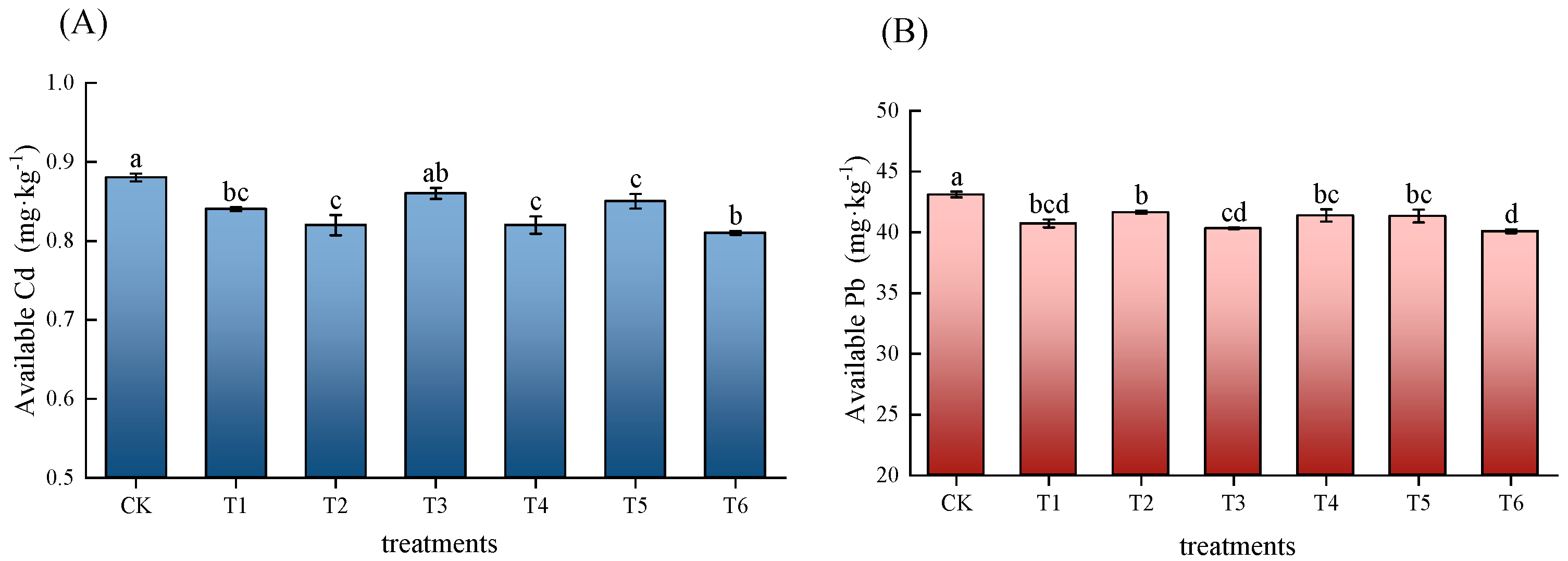
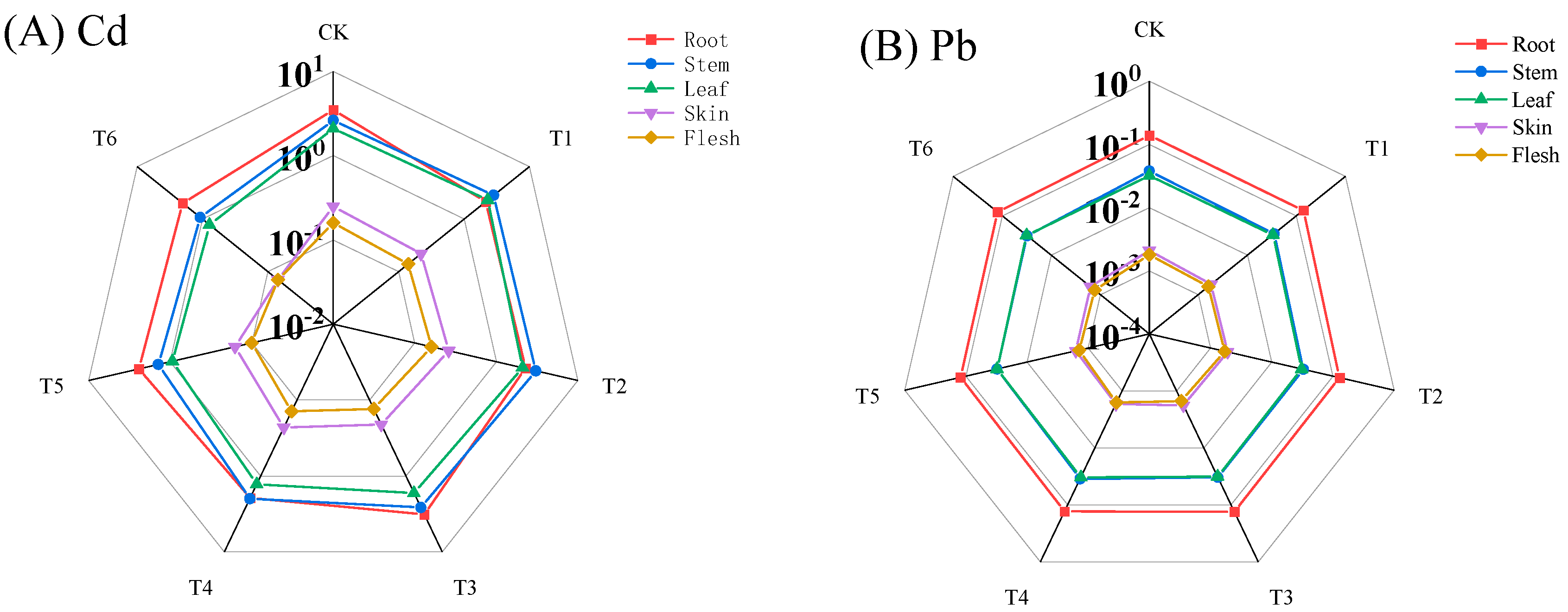
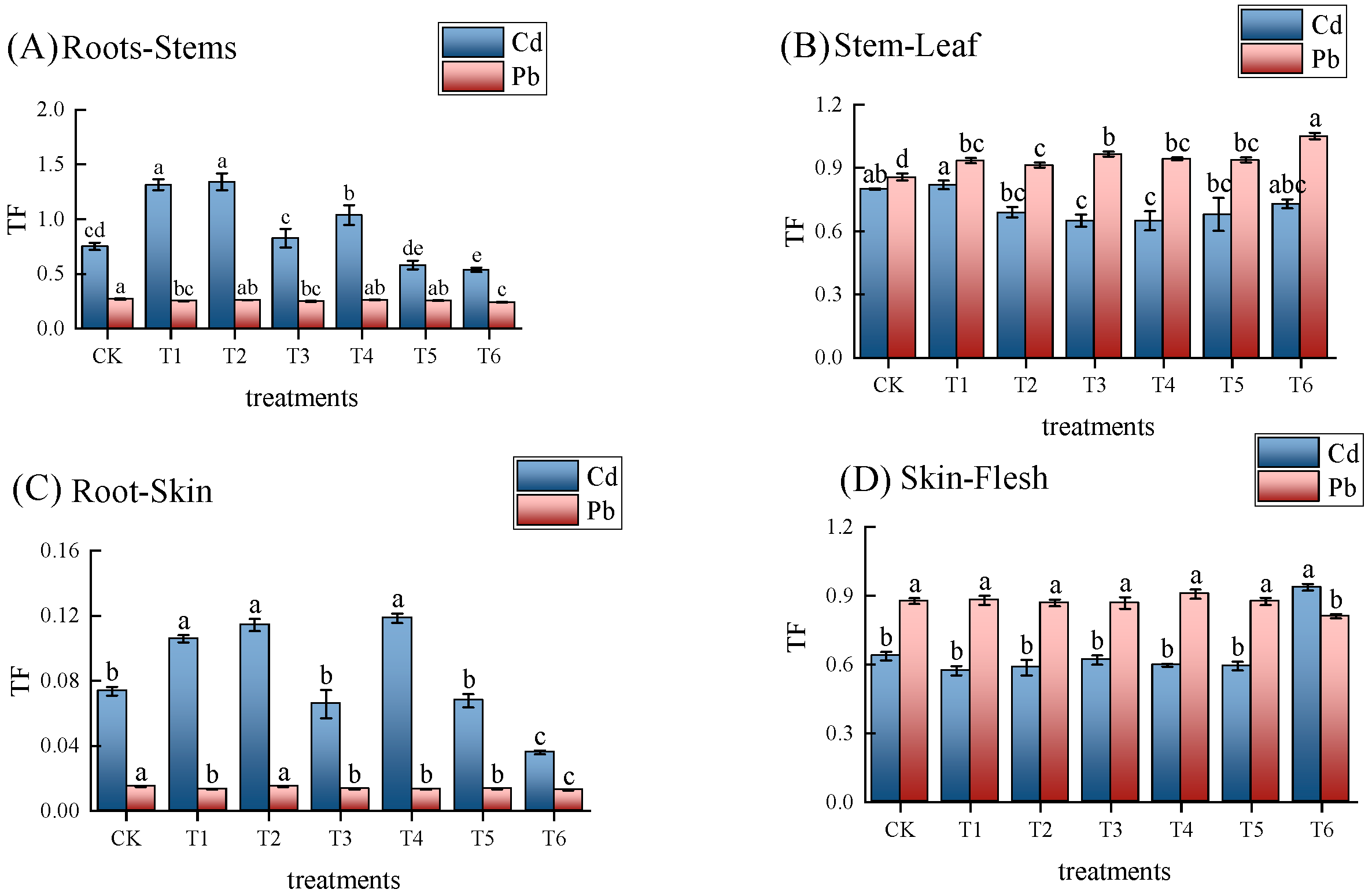
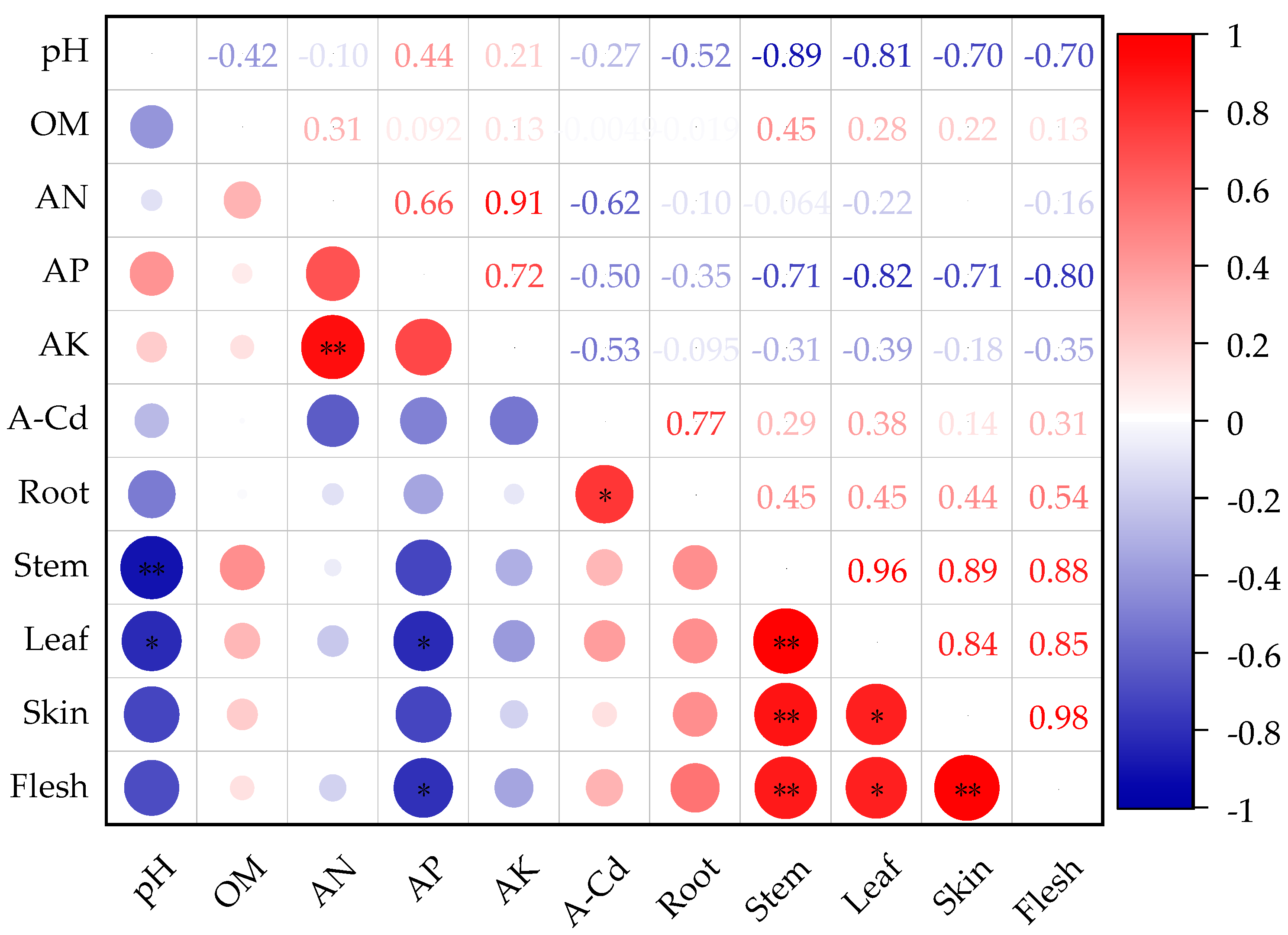
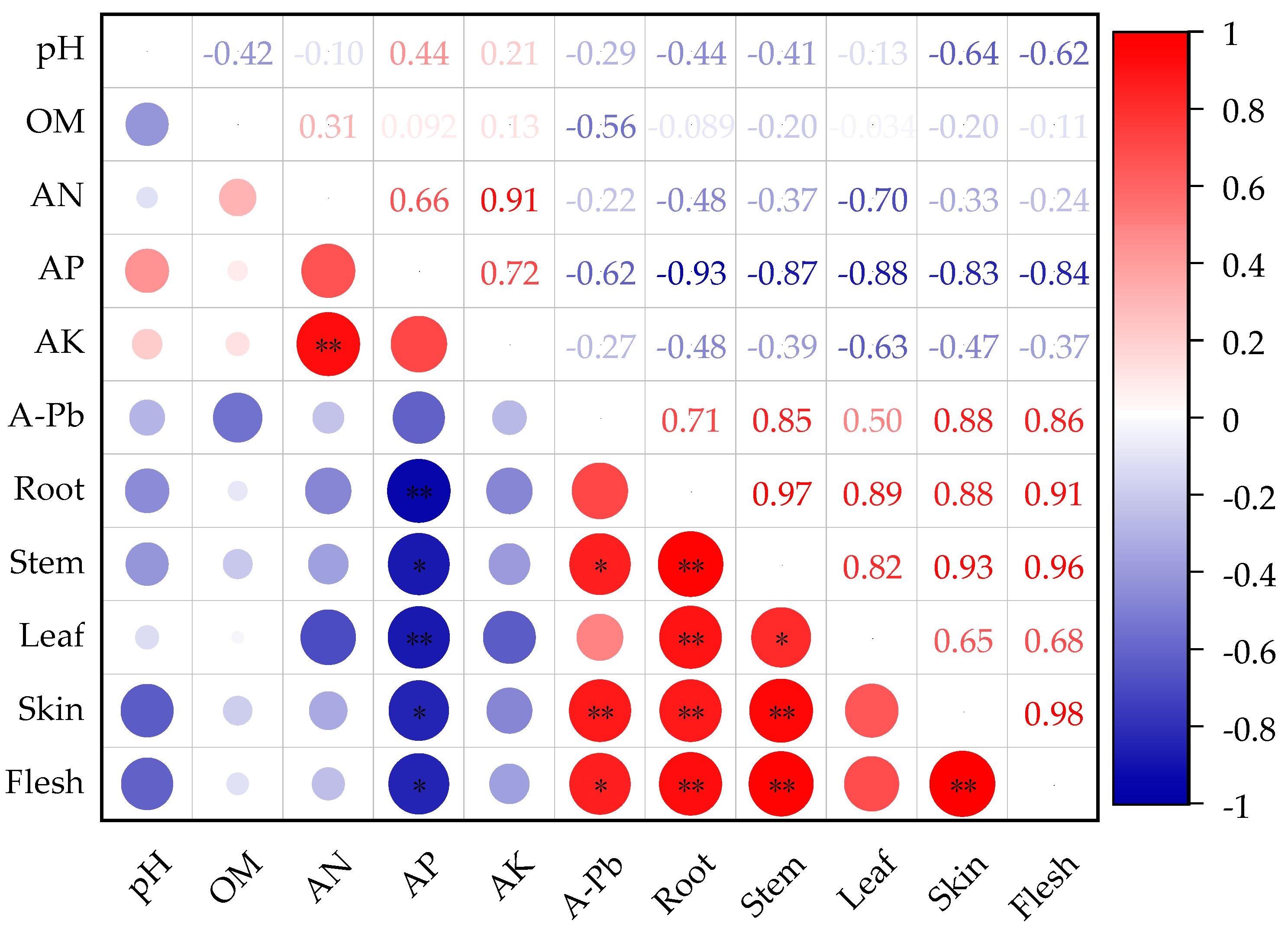
| pH | CEC | OM | AN | AP | AK | Cd | Pb | Soil Texture (%) | ||
|---|---|---|---|---|---|---|---|---|---|---|
| (cmo·kg−1) | (g·kg−1) | (mg·kg−1) | (mg·kg−1) | (mg·kg−1) | (mg·kg−1) | (mg·kg−1) | Sand | Clay | Silt | |
| 5.36 | 18 | 19.99 | 153.73 | 15.64 | 393 | 6.42 | 273.69 | 20 | 40 | 30 |
| Treatments | Treatment Establishment | Usage and Dosage |
|---|---|---|
| CK | Control | --- |
| T1 | Special potato fertilizer (16-10-6) | 1500 kg·hm−2 |
| T2 | Humic acid (>20%) | 1500 kg·hm−2 |
| T3 | Potato fertilizer + humic acid | 1500 kg·hm−2 (special fertilizer–soil conditioner 1:1) |
| T4 | Biochar (15-7-18) | 1500 kg·hm−2 |
| T5 | Calcium magnesium phosphate (P2O5 ≥ 12%) | 1500 kg·hm−2 |
| T6 | Biochar + calcium magnesium phosphate | 1500 kg·hm−2 (Biochar–calcium magnesium phosphate 1:1) |
| Treatments | pH | OM (g·kg−1) | AN (mg·kg−1) | AP (mg·kg−1) | Ak (mg·kg−1) |
|---|---|---|---|---|---|
| CK | 6.12 ± 0.02 e | 18.39 ± 0.80 e | 101.34 ± 13.07 d | 14.26 ± 1.02 f | 191.33 ± 6.11 e |
| T1 | 6.34 ± 0.04 d | 33.44 ± 0.90 b | 139.92 ± 16.16 c | 22.82 ± 2.12 e | 241 ± 5.29 c |
| T2 | 5.2 ± 0.04 b | 31.67 ± 0.51 bc | 161.89 ± 16.63 c | 30.59 ± 1.71 d | 214 ± 7.00 d |
| T3 | 5.8 ± 0.03 a | 35.54 ± 1.21 a | 184.54 ± 9.33 b | 43.3 ± 0.93 b | 281.33 ± 3.21 b |
| T4 | 7.76 ± 0.02 c | 30.73 ± 2.36 c | 147.31 ± 11.40 c | 33.2 ± 0.95 c | 245.67 ± 12.01 c |
| T5 | 7.42 ± 0.03 f | 20.2 ± 1.04 e | 214.17 ± 9.06 a | 53.64 ± 1.13 a | 342.67 ± 9.71 a |
| T6 | 7.87 ± 0.03 e | 24.12 ± 1.01 d | 105.38 ± 8.95 d | 43.65 ± 1.58 b | 202.33 ± 6.66 de |
| Treatment | Root (mg·kg−1) | Stem (mg·kg−1) | Leaf (mg·kg−1) | Skin (mg·kg−1) | Flesh (mg·kg−1) | |
|---|---|---|---|---|---|---|
| CK | 15.37 ± 1.23 a | 11.52 ± 0.04 a | 9.23 ± 0.08 b | 1.13 ± 0.14 a | 0.72 ± 0.11 a | |
| T1 | 9.17 ± 0.12 c | 12.04 ± 0.66 a | 9.86 ± 0.29 a | 0.97 ± 0.02 ab | 0.54 ± 0.01 b | |
| T2 | 9.34 ± 0.31 c | 12.49 ± 0.85 a | 8.62 ± 0.11 c | 1.06 ± 0.02 ab | 0.57 ± 0.02 b | |
| Cd | T3 | 13.65 ± 1.33 b | 11.12 ± 0.89 a | 7.20 ± 0.30 d | 0.88 ± 0.19 b | 0.47 ± 0.11 b |
| T4 | 7.95 ± 0.30 c | 8.20 ± 0.94 b | 5.27 ± 0.33 e | 0.94 ± 0.03 ab | 0.50 ± 0.02 b | |
| T5 | 9.81 ± 0.48 c | 5.68 ± 0.37 c | 3.81 ± 0.54 f | 0.66 ± 0.01 c | 0.35 ± 0.04 c | |
| T6 | 8.37 ± 0.43 c | 4.50 ± 0.14 d | 3.26 ± 0.06 g | 0.30 ± 0.02 d | 0.25 ± 0.01 d | |
| CK | 39.99 ± 0.25 a | 10.79 ± 0.46 a | 9.23 ± 0.11 a | 0.53 ± 0.01 a | 0.34 ± 0.06 a | |
| T1 | 37.49 ± 0.41 b | 9.52 ± 0.075 b | 8.90 ± 0.21 abc | 0.49 ± 0.02 c | 0.28 ± 0.03 bc | |
| T2 | 35.57 ± 0.38 c | 9.27 ± 0.077 b | 8.47 ± 0.12 cd | 0.50 ± 0.01 b | 0.29 ± 0.01 b | |
| Pb | T3 | 35.44 ± 0.76 c | 8.88 ± 0.095 c | 8.57 ± 0.11 bcd | 0.47 ± 0.01 d | 0.26 ± 0.02 cd |
| T4 | 36.22 ± 0.87 c | 9.51 ± 0.13 b | 8.97 ± 0.13 ab | 0.47 ± 0.04 d | 0.29 ± 0.04 bc | |
| T5 | 33.61 ± 0.56 d | 8.653 ± 0.15 c | 8.12 ± 0.04 d | 0.44 ± 0.06 e | 0.25 ± 0.06 d | |
| T6 | 33.33 ± 0.84 d | 8.08 ± 0.18 d | 8.50 ± 0.41 cd | 0.41 ± 0.01 f | 0.20 ± 0.01 e |
| Treatment | Yield (kg·hm−2) | Vitamin Content (mg·100 g−1) | Starch Content (g·100 g−1) | Contents of Soluble Sugar (g·100 g−1) |
|---|---|---|---|---|
| CK | 21,090.67 ± 1530.04 c | 10.08 ± 0.06 c | 15.53 ± 0.42 d | 2.50 ± 0.04 a |
| T1 | 28,716.64 ± 1005.94 a | 13.50 ± 0.34 a | 14.90 ± 0.32 e | 1.60 ± 0.01 c |
| T2 | 22,850.64 ± 1477.19 bc | 10.26 ± 0.23 c | 15.79 ± 0.60 c | 2.26 ± 0.09 b |
| T3 | 23,621.61 ± 809.76 abc | 10.43 ± 0.03 c | 17.12 ± 1.14 b | 2.70 ± 0.14 a |
| T4 | 27,795.48 ± 849.16 ab | 12.00 ± 0.04 b | 15.61 ± 0.55 cd | 2.48 ± 0.07 a |
| T5 | 26,479.52 ± 568.90 ab | 11.55 ± 0.05 b | 17.50 ± 0.70 a | 2.52 ± 0.05 a |
| T6 | 24,312.83 ± 1022.61 abc | 10.41 ± 0.34 c | 14.75 ± 0.23 e | 2.53 ± 0.18 a |
Disclaimer/Publisher’s Note: The statements, opinions and data contained in all publications are solely those of the individual author(s) and contributor(s) and not of MDPI and/or the editor(s). MDPI and/or the editor(s) disclaim responsibility for any injury to people or property resulting from any ideas, methods, instructions or products referred to in the content. |
© 2024 by the authors. Licensee MDPI, Basel, Switzerland. This article is an open access article distributed under the terms and conditions of the Creative Commons Attribution (CC BY) license (https://creativecommons.org/licenses/by/4.0/).
Share and Cite
Wang, L.; Zhou, H.; Yang, K.; Er Ze, L.; Lu, Z.; Li, Y.; Mu, L.; Zhang, N. Reducing Cd and Pb Accumulation in Potatoes: The Role of Soil Passivators in Contaminated Mining Soils. Life 2024, 14, 1615. https://doi.org/10.3390/life14121615
Wang L, Zhou H, Yang K, Er Ze L, Lu Z, Li Y, Mu L, Zhang N. Reducing Cd and Pb Accumulation in Potatoes: The Role of Soil Passivators in Contaminated Mining Soils. Life. 2024; 14(12):1615. https://doi.org/10.3390/life14121615
Chicago/Turabian StyleWang, Lijuan, Hongyin Zhou, Ke Yang, Ladu Er Ze, Zhengli Lu, Yingmei Li, Liyuan Mu, and Naiming Zhang. 2024. "Reducing Cd and Pb Accumulation in Potatoes: The Role of Soil Passivators in Contaminated Mining Soils" Life 14, no. 12: 1615. https://doi.org/10.3390/life14121615
APA StyleWang, L., Zhou, H., Yang, K., Er Ze, L., Lu, Z., Li, Y., Mu, L., & Zhang, N. (2024). Reducing Cd and Pb Accumulation in Potatoes: The Role of Soil Passivators in Contaminated Mining Soils. Life, 14(12), 1615. https://doi.org/10.3390/life14121615




